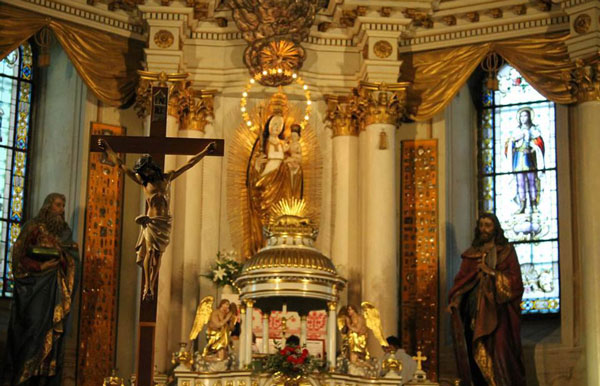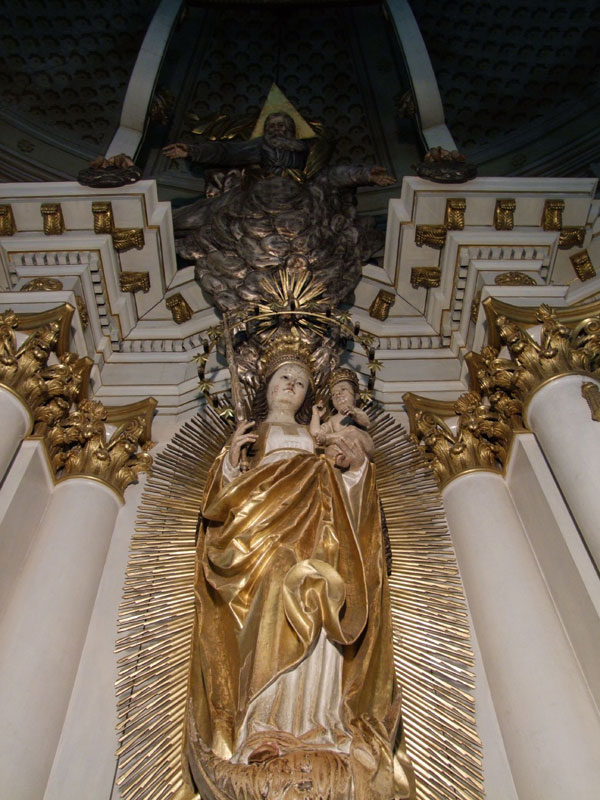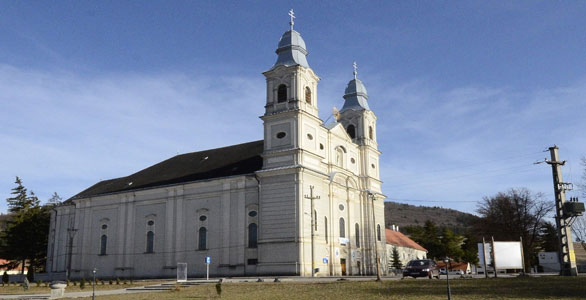Overview
The largest annual gathering of any kind in Romania is an annual pilgrimage event at the Csíksomlyó pilgrimage site. This event attracts over 100,000 people every year.
Virgin Mary, ornamented with wonders, of Csíksomlyó. Protect and help your Székely people!
Csíksomlyó Pilgrimage is also chosento be in the European Marian Network of Marian Pilgrimage Sites.
At the pilgrimage site, people visit a miraculous statue of the Virgin Mary, where they pray for intercessions and wipe the statue with cloths so that their children will be healed and protected from harm.

Csíksomlyó as pilgrimage site
Csíksomlyó became a pilgrimage site in 1442. In the 1990s the church and the surrounding region could no longer accommodate the hundreds of thousands pilgrims. In 1993, a new altar was built at the mountain side and since then the celebration of the Eucharist have been taking place outdoors.
See Top 15 Catholic shrines around the world.
See more European catholic shrines and pilgrimages.
Mass times
Sundays and feast days:
- 8 00, 10 30, 18 00 (in winter) and 8 00, 10 30, 19 00 (in summer)
On weekdays:
- 7 30, 18 00 (in winter) and 7 30, 19 00 (in summer).
Pilgrims and groups are welcome every day of the year
The Statue of the Virgin Mary
The most important creation of the Pilgrimage Church is the statue that represents the Virgin Mary.
This was made of linden wood in Renaissance style between the years 1510 and 1515. The artist who created it is unknown. Its height is 227 cm and it is the highest of all statues known in the world.
It represents the Lady Dressed in the Sun who has the moon under her feet and a wreath made of twelve stars around her head.
There is also a crown on her head, in her right hand a scepter, in her left arm her Holy Son, the baby Jesus. In 1798 it was recognized as miraculous by the bishop Ignác Batthyány and he gave her the following name: “Wonderful and helpful Mother in protecting against heretics”.
During the centuries many miracles happened with the statue. Several times it was shining so that its light filled the church.
In 1661 the church was ravaged by Tartars and Turks and it was set on fire. In a miraculous way the statue remained undamaged.
In the previous centuries, until the 1950s the baby Jesus used to be dressed. The colour of its dress changed according to the ecclesiastical liturgy.
On the right of the statue there are two statues. The one on the right represents King Saint Stephen and the one on the left represents Saint Ladislas. Both of them are 260 cm tall and were made in Grönd, in Tirol in 1905.
Many prayers were listened in the intercession of the Virgin Mary. The memory of this is kept on the metallic objects, the so called votive objects, on both sides of the statue of Mary. These were brought in by the believers as a sign of their gratitude as their prayers had been heard.
The metallic objects representing hands, feet, hearts and other body parts date back to the 18th century and were made from different materials among them gold and silver. Several valuables were sold and the money was used in the construction of the present church.
The marble tablets have been made since the 1940s are the evidence that the prayers have been heard.


The Story of the Pilgrimage Church Csíksomlyó
The Gothic Church
We don’t know the exact date when the original church was built but we have information on the first reconstruction of the church between 1442 and 1448 due to Tatar invasion.
In that period a bigger Gothic church and a small Gothic monastery were constructed. János Hunyadi, voivode of Tran-sylvania, helped in the construction of the church in gratitude for winning the battle against the Turks in 1442.
It was consecrated in 1448 in honour of Sarlós Boldogasszony.
From 1440, the church and the monastery were surrounded by strong stonewalls. To this place the people of the region made their escape from the repeated invasions between the 16th and 17th centuries.
The Gothic church and monastery were restored and amplified several times between the 17th and 18th centuries. The structure that exists today was built between the years 1773 and 1779.
The Baroque Church
The church with its Gothic style existed until 1802; its material was built into the present Baroque church.
The construction of the Baroque Pilgrimage Church was started in 1804 according to the plan of the engineer Konstantin Schmidt. The furnishing was made by Miklós Papp, painter and sculptor from Brassó. The side altars were built at the beginning of the 19th century during the construction of the church.
The church was consecrated on the 20th August 1876 by Mihály Fogarassy, Transylvania’s bishop, and in 1948 Pope Pius XII raised it to the dignity of Basilica Minor.
- The current church is 58 m long, the nave is 22 m and the sanctuary is 17 m
broad. - The height of the nave is 18 m and
- the tower up to the cross is 55 m.
The altars and statues in the Church
- The Altar of the Suffering Jesus
- The Saint’s Tomb Altar – the Altar of the Suffering Jesus can be found under the choir. It was made in 1855, its donor is unknown.
- The Saint Teresa statue was donated by Dr. Jenőné Hegyi from Budapest in 1933.
- The Saint Joseph statue was made by Gábor Vágó in 1938 and it was a gift from Lajos Szopos.
- The Altar of Saint John the Baptist was made in 1840 and it was a gift from János Lukács, a dealer from Csíkszerda, and his wife, Sára Mánya. The picture above represents Saint Sarah and the one below the altar represents Mary Magdalene.
- The altar of Saint John of Nepomuk was donated by János Botsántzi and his sons in 1935. It was made by Miklós Papp. The upper picture represents Mary´s visit to Elizabeth and the lower one depicts Saint Vendel in high priest’s clothing.
- The altar of Saint Anne was made in 1839 and it was a donation from widow Mártonné Rakovszky and baron Anna Henter. It was made by Miklós Papp. In the upper picture Saint Apollonia can be seen and below the altar another picture represents Jesus’ birth.
- The Saint Elizabeth altar-piece was made in 1938. The altar was placed in the church by Bálint Ignác and his wife, Juliánna Bors in honour of Saint Ignatius of Loyola. The picture of Saint Ignatius was changed for a picture representing Saint Elizabeth. The picture representing Saint Ignatius can be found in the church’s choir.
- The altar of Saint Francis was made in 1840. The upper picture representing Saint Nicholas was painted by Miklós Papp. The lower picture representing Saint Francis of Assisi was the creation of József Csűrös, painted in 1838 in Kolozsvár.
- The altar of St. Anthony was placed in the church in 1843 and it was donated by Antal Zakariás. The original main picture of the altar was donated to the chapel at Sófalva in 1931.


The Pulpit
The pulpit was made by the fine artist, Miklós Papp in 1835. On the side it has a relief representing the coming of the Holy Spirit and the four Evangelists. On the relief on the door, Moses is portrayed presenting God’s 10 commandments written on two slabs of stone. On the top of the pulpit the archangel Saint Michael can be seen.
The ceiling of the church was made of wood. On the arch there is a cronosticon in Latin: ECCe MarIa pIo rVtILant tVa teCta nItore, qVae tIbI FranCIsCI tVrba pVsILLa LoCat.
(There Maria your shelter built by Saint Francisco’s little flock shines with honour)
Latin-rite Catholics in Romania
Latin-rite Catholics in Romania are members of an ethnic Hungarian minority, a small community surrounded by Orthodox Christians in one of Europe’s most religiously observant societies. Catholics live mostly in homogenous enclaves in the eastern part of the Transylvania region.
The beginning of the pilgrimage, which is still alive today, goes back to Pentecost of 1567. At the time the Hungariana king (a non-Catholic), Zsigmond Janos (1540-1571) with his Protestant army attacked the Catholics assembled for what amounted to a congress to force them to abandon their faith; however, he suffered a defeat, which was ascribed to the help of the Virgin Mary.
During the four hundred years of its existence, the pilgrimage center has served as a meeting place for the so-called Csango-Hungarians who had settled in Moldavia and for the Catholic Hungarians in Transylvania for whom it is also an important spiritual and cultural center. The place has an important role in the preservation of their national identity.
The Patronal Festival
The Patronal Festival is celebrated on 2 July, the day of the Visitation and in the Catholic Church it was started by the Franciscans during the 13th century.
They brought it to Csíksomlyó as well, which might be the reason for which the Pilgrimage Church was devoted to the Visitation in 1448.
Before the period of the Gothic church there existed reverence towards the Virgin Mary promoted by the Franciscans.
Pope Eugene IV gave evidence of this: “a multitude of the faithful comes together to worship and they do not stop gathering together often.”
The Pentecost Patronal Festival
During the Reformation, in 1567, Zsigmond János, Prince of Transylvania, wanted to convert the Catholics from Csík, Gyergyó and Kászon to the Unitarian Church with the help of the army.
The three Szeklers territories defended their faith with the leadership of Stephen, parish priest of Gyergyóalfalu.
From the 1990s the procession that was prohibited before the 1950’s started. Since 1993, as a result of the increasing number of pilgrims, the holy mass has been celebrated in the saddle between the Mountains of Kissomlyó and Nagysomlyó.
Nowadays the clerical cordon and the pilgrims joining them take part in the procession following the same route as before.
In May 7, 1936 the Holy See allowed that every day a person who visits the Pilgrimage Church of Csíksomlyó, confesses, receives Holy Communion and prays for the intention of the Pope can earn total indulgence.
Source:
Photos:
- By Coco_ro from Timişoara, Romania – Flickr, CC BY 2.0
- By Einstein2 – Own work, CC BY-SA 3.0
- www.csiksomlyo.ro
Let us remain close in the same prayer! May the Lord bless you abundantly!
Video
The Patronal Festival
The Patronal Festival is celebrated on 2 July, the day of the Visitation and in the Catholic Church it was started by the Franciscans during the 13th century.
They brought it to Csíksomlyó as well, which might be the reason for which the Pilgrimage Church was devoted to the Visitation in 1448.
Before the period of the Gothic church there existed reverence towards the Virgin Mary promoted by the Franciscans.
Pope Eugene IV gave evidence of this: “a multitude of the faithful comes together to worship and they do not stop gathering together often.”
The Statue of the Virgin Mary
The most important creation of the Pilgrimage Church is the statue that represents the Virgin Mary.
This was made of linden wood in Renaissance style between the years 1510 and 1515. The artist who created it is unknown. Its height is 227 cm and it is the highest of all statues known in the world.
It represents the Lady Dressed in the Sun who has the moon under her feet and a wreath made of twelve stars around her head.
There is also a crown on her head, in her right hand a scepter, in her left arm her Holy Son, the baby Jesus. In 1798 it was recognized as miraculous by the bishop Ignác Batthyány and he gave her the following name: “Wonderful and helpful Mother in protecting against heretics”.
During the centuries many miracles happened with the statue. Several times it was shining so that its light filled the church.
In 1661 the church was ravaged by Tartars and Turks and it was set on fire. In a miraculous way the statue remained undamaged.
In the previous centuries, until the 1950s the baby Jesus used to be dressed. The colour of its dress changed according to the ecclesiastical liturgy.
Votive Objects
On the right of the statue there are two statues. The one on the right represents King Saint Stephen and the one on the left represents Saint Ladislas. Both of them are 260 cm tall and were made in Grönd, in Tirol in 1905.
Many prayers were listened in the intercession of the Virgin Mary. The memory of this is kept on the metallic objects, the so called votive objects, on both sides of the statue of Mary. These were brought in by the believers as a sign of their gratitude as their prayers had been heard.
The metallic objects representing hands, feet, hearts and other body parts date back to the 18th century and were made from different materials among them gold and silver. Several valuables were sold and the money was used in the construction of the present church. The marble tablets have been made since the 1940s are the evidence that the prayers have been heard.
Let us remain close in the same prayer! May the Lord bless you abundantly!
Let us remain close in the same prayer! May the Lord bless you abundantly!
Sundays and feast days:
- 8 00, 10 30, 18 00 (in winter) and 8 00, 10 30, 19 00 (in summer)
On weekdays:
- 7 30, 18 00 (in winter) and 7 30, 19 00 (in summer).
Pilgrims and groups are welcome every day of the year
Let us remain close in the same prayer! May the Lord bless you abundantly!
Let us remain close in the same prayer! May the Lord bless you abundantly!
Let us remain close in the same prayer! May the Lord bless you abundantly!
Let us remain close in the same prayer! May the Lord bless you abundantly!
The Baroque Church
The church with its Gothic style existed until 1802; its material was built into the present Baroque church.
The construction of the Baroque Pilgrimage Church was started in 1804 according to the plan of the engineer Konstantin Schmidt. The furnishing was made by Miklós Papp, painter and sculptor from Brassó. The side altars were built at the beginning of the 19th century during the construction of the church.
The church was consecrated on the 20th August 1876 by Mihály Fogarassy, Transylvania’s bishop, and in 1948 Pope Pius XII raised it to the dignity of Basilica Minor.
- The current church is 58 m long, the nave is 22 m and the sanctuary is 17 m
broad. - The height of the nave is 18 m and
- the tower up to the cross is 55 m.
The altars and statues in the Church
- The Altar of the Suffering Jesus
- The Saint’s Tomb Altar – the Altar of the Suffering Jesus can be found under the choir. It was made in 1855, its donor is unknown.
- The Saint Teresa statue was donated by Dr. Jenőné Hegyi from Budapest in 1933.
- The Saint Joseph statue was made by Gábor Vágó in 1938 and it was a gift from Lajos Szopos.
- The Altar of Saint John the Baptist was made in 1840 and it was a gift from János Lukács, a dealer from Csíkszerda, and his wife, Sára Mánya. The picture above represents Saint Sarah and the one below the altar represents Mary Magdalene.
- The altar of Saint John of Nepomuk was donated by János Botsántzi and his sons in 1935. It was made by Miklós Papp. The upper picture represents Mary´s visit to Elizabeth and the lower one depicts Saint Vendel in high priest’s clothing.
- The altar of Saint Anne was made in 1839 and it was a donation from widow Mártonné Rakovszky and baron Anna Henter. It was made by Miklós Papp. In the upper picture Saint Apollonia can be seen and below the altar another picture represents Jesus’ birth.
- The Saint Elizabeth altar-piece was made in 1938. The altar was placed in the church by Bálint Ignác and his wife, Juliánna Bors in honour of Saint Ignatius of Loyola. The picture of Saint Ignatius was changed for a picture representing Saint Elizabeth. The picture representing Saint Ignatius can be found in the church’s choir.
- The altar of Saint Francis was made in 1840. The upper picture representing Saint Nicholas was painted by Miklós Papp. The lower picture representing Saint Francis of Assisi was the creation of József Csűrös, painted in 1838 in Kolozsvár.
- The altar of St. Anthony was placed in the church in 1843 and it was donated by Antal Zakariás. The original main picture of the altar was donated to the chapel at Sófalva in 1931.















